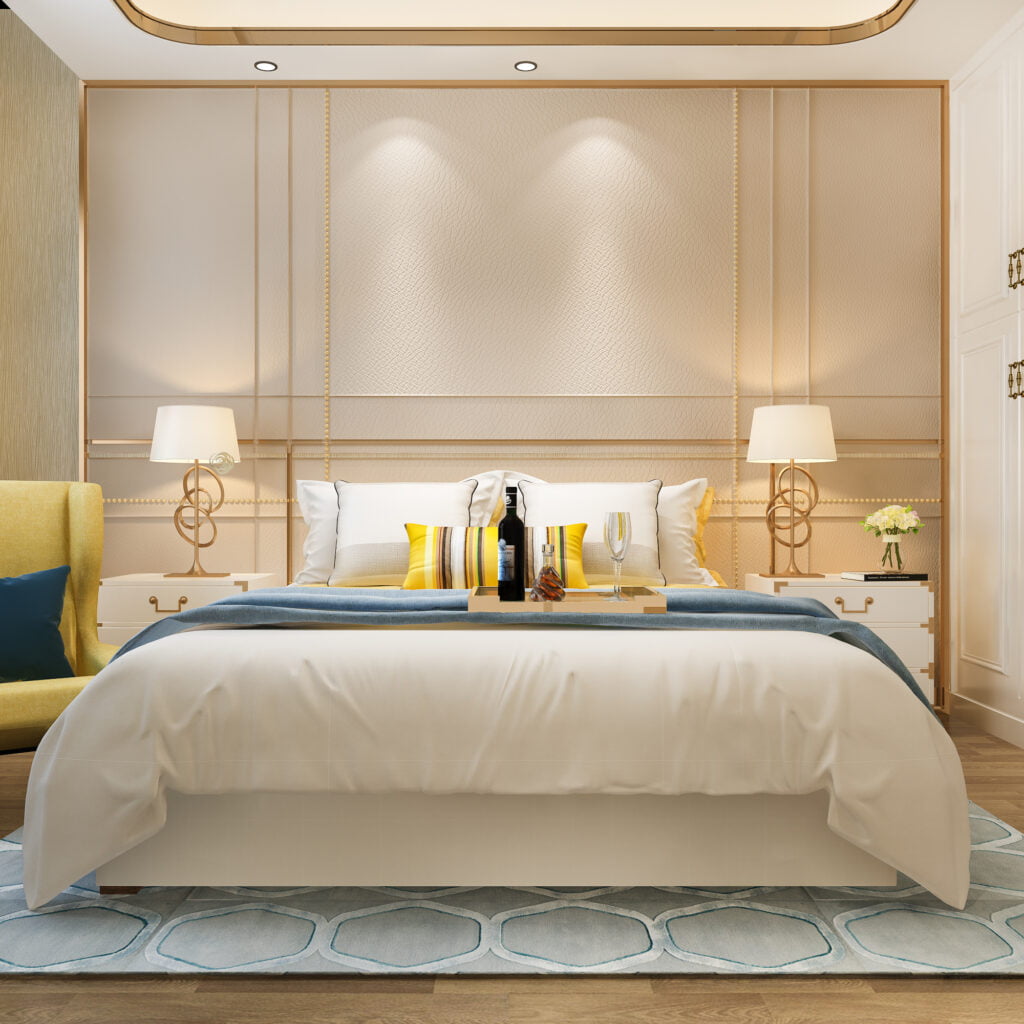
Introduction
Having a well-designed bedroom is for creating a comfortable and functional space that promotes restful sleep and overall well-being. The design choices we make in our bedrooms can have a profound impact on our quality of sleep and daily productivity. In this blog post, we will explore various modern bedroom design ideas to help you create a sanctuary that aligns with your personal style while optimizing comfort and functionality.
Choosing the Right Color Palette
The colors we choose for our bedroom can significantly influence our mood and level of relaxation. Understanding the psychology of colors is crucial when selecting the perfect color palette.
Calming colors for relaxation
Soft, muted tones such as blues, greens, and lavenders are known for their calming effects. These colors create a peaceful and serene environment that can facilitate relaxation and a sense of tranquility. Opt for light shades of these colors to maximize their soothing impact.
Energizing colors for productivity
If you want your bedroom to serve as a space for work or studying, consider incorporating energizing colors. Shades of yellow or orange can promote productivity and stimulate mental focus. However, be cautious when using these colors in large amounts, as they may become overwhelming and hinder your ability to unwind.
Colors to avoid for better sleep
While vibrant and bold colors may be visually appealing, they are generally not recommended for bedrooms. Bright reds, intense yellows, and vibrant oranges can create a stimulating environment that may interfere with your ability to fall asleep. It’s best to reserve these colors for accent pieces or accessories.
Harmonizing colors with furniture and decor is crucial in achieving a cohesive and visually pleasing bedroom design.
Complementary color schemes
Complementary colors are those that are opposite each other on the color wheel, creating a pleasing contrast. Incorporating complementary colors in your bedroom design can add visual interest and depth. For example, pair shades of blue with warm sandy tones, or green with shades of purple.
Monochromatic color schemes
For a more minimalist and streamlined look, consider using a monochromatic color scheme. This involves using various shades of the same color throughout the room. Monochromatic designs can create a sense of harmony and unity, making your bedroom feel calm and balanced.
Accent colors for visual interest
To add pops of color and visual interest, incorporate accent colors through accessories and decor. This can include vibrant throw pillows, artwork, or a brightly colored rug. Accent colors can be selected to complement or contrast with the main color palette, depending on your personal style preferences.
Optimal Furniture Arrangement
The layout of your bedroom plays a significant role in creating a functional and aesthetically pleasing space. When arranging furniture, consider the following factors:
Assessing the bedroom layout
Begin by assessing the natural light and ventilation in your bedroom. Position your bed and other furniture in a way that maximizes the amount of natural light entering the room. Good airflow and ventilation promote a fresh and comfortable environment.
Considering traffic flow and accessibility
Ensure that the furniture layout allows for smooth traffic flow in and out of the room. Avoid blocking doorways or creating cramped spaces that can hinder movement. Accessibility is essential for a truly functional bedroom.
Positioning furniture for comfort and functionality
Place your bed in a position that allows you to easily access both sides. Consider the location of electrical outlets for convenient access to charging points for devices. Arrange bedside tables and lamps within reach, providing functionality and convenience.
Space-saving solutions are particularly important for smaller bedrooms or rooms with limited square footage.
Utilizing multifunctional furniture
Investing in multifunctional furniture can be a game-changer for smaller bedrooms. Look for beds with built-in storage solutions, such as drawers or under-bed compartments. This allows you to maximize storage space while keeping the room clutter-free.
Incorporating storage options
Consider utilizing vertical space by incorporating wall-mounted shelves or floating bedside tables. This not only provides additional storage for books, plants, or decorative items but also creates the illusion of a spacious room.
Creating the illusion of space with mirrors
Mirrors have the remarkable ability to make a room appear larger than it is. Strategically placing mirrors on walls or wardrobe doors can reflect natural light and create an open and airy atmosphere. Mirrors also add depth to the room, making it feel more expansive.
Creating a Tranquil Sleep Environment
The focal point of any bedroom is the bed itself. When selecting the right bed and mattress, there are a few key considerations to keep in mind.
Choosing the right bed and mattress
Finding the perfect mattress is essential for a good night’s sleep. It’s important to choose a mattress that offers the right balance of support and comfort. Mattress firmness can vary depending on individual preferences, but a medium-firm mattress is generally recommended for optimal spinal alignment.
Selecting an appropriate bed size
Consider the size of your bedroom when selecting a bed. A bed that is too large for the room can make the space feel cramped and hinder movement. Choose a bed size that allows for comfortable circulation and leaves enough space for other furniture pieces.
Incorporating stylish and functional bed frames
Bed frames not only provide support for your mattress but also serve as a statement piece in your bedroom. Choose a bed frame that aligns with your personal style while offering functionality. Options such as platform beds with built-in storage or adjustable bed frames can enhance comfort and maximize space utilization.
Enhancing sleep quality extends beyond just the bed and mattress. Bedding and accessories play a crucial role in creating a tranquil sleep environment.
Optimal thread counts and fabric choices for sheets
When choosing sheets, consider the fabric and thread count. Natural fibers such as cotton or linen are breathable and help regulate body temperature, promoting a comfortable night’s sleep. Aim for a thread count between 200 and 400 for soft and durable sheets.
Pillows and pillow arrangement for neck support
The right pillow and its arrangement are vital for proper neck support and alignment. Choose a pillow that suits your preferred sleeping position – whether you sleep on your side, back, or stomach. Experiment with different pillow arrangements to find the most comfortable and supportive configuration for you.
Blackout curtains or blinds for better sleep quality
Create a sleep-friendly environment by incorporating blackout curtains or blinds. These block out external light sources, ensuring a dark and peaceful atmosphere essential for a good night’s sleep. Blackout window treatments also provide privacy and can help reduce outside noise, further improving sleep quality.
Incorporating Personal Style and Décor
Infusing your personal style into your bedroom design is essential for creating a space that truly feels like home.
Reflecting personal preferences
Identify your personal style preferences and translate them into your bedroom design. Whether you prefer a modern, minimalist look or a cozy, bohemian vibe, let your style shine through in your choice of furniture, textures, and accessories.
Incorporating meaningful artwork and photographs
Hang artwork or display photographs that hold personal significance to you. Art has the power to evoke emotions and memories, creating a space that feels uniquely yours. Opt for pieces that reflect your taste and contribute to the overall ambiance you want to create.
Displaying cherished items and collections
Showcase cherished items or collections that have sentimental value. This can include anything from travel souvenirs to family heirlooms. Incorporating these personal touches can make your bedroom feel more intimate and inviting.
Creating a cozy and inviting atmosphere
Textiles and lighting play a crucial role in creating a cozy and inviting atmosphere in your bedroom.
Incorporating soft textures and fabrics
Introduce soft textures and fabrics through rugs, throw blankets, and cushions. These add warmth and comfort to the space, making it feel welcoming. Opt for plush materials like faux fur or chunky knit for a luxurious touch.
Introducing layers of lighting for ambiance
Lighting sets the mood in your bedroom. Incorporate multiple light sources, such as bedside lamps, ceiling lights, or wall sconces, to create layers of lighting. This allows you to adjust the ambiance depending on your needs – whether you desire a bright and energizing atmosphere or a soft and relaxing glow.
Adding plants and greenery for a touch of nature
Bring a touch of nature into your bedroom by incorporating plants and greenery. Not only do plants add visual appeal, but they also improve air quality and contribute to a calm and restful environment. Select low-maintenance plants that thrive in indoor conditions, such as pothos or snake plants.
Summary
Creating a well-designed bedroom goes beyond aesthetic appeal – it directly impacts your well-being and quality of sleep. By choosing the right color palette, furniture arrangement, sleep environment elements, and incorporating personal style, you can transform your bedroom into a sanctuary tailored to your needs. Remember to prioritize comfort, functionality, and personal preferences throughout the design process.
FAQs
- How can I make a small bedroom feel more spacious?
- Opt for light-colored walls and furniture to create an airy feel.
- Utilize mirrors to reflect light and create the illusion of space.
- Incorporate multifunctional furniture and maximize storage options.
- Keep the room clutter-free and organized.
- What colors are best for promoting relaxation in the bedroom?
- Calming colors such as blues, greens, and lavenders are known for their relaxing properties.
- Lighter shades of these colors can create a serene and peaceful atmosphere conducive to relaxation and sleep.
- What is the ideal mattress firmness for a good night’s sleep?
- The ideal mattress firmness varies depending on individual preferences.
- A medium-firm mattress is generally recommended for optimal comfort and spinal alignment.
- How can I incorporate personal style without overcrowding the space?
- Focus on selecting key furniture pieces that reflect your personal style.
- Incorporate meaningful artwork, photographs, or cherished items to add personal touches.
- Avoid overcrowding the space by keeping the overall design cohesive and minimalist.
- What are some budget-friendly options for bedroom decor?
- Upcycle or repurpose existing furniture for a cost-effective option.
- DIY projects such as creating your own artwork or crafting decorative items.
- Shop for affordable decor pieces at thrift stores, flea markets, or online marketplaces.
Remember, creating a modern bedroom design is about creating a space that caters to your preferences and promotes restful sleep. Experiment with different elements and trust your instincts to curate a bedroom that truly represents you. Happy designing!

